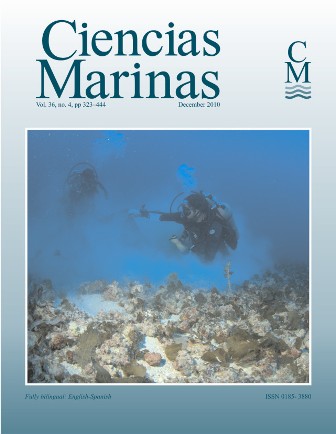Seasonal variations of the thermohaline structure in the Magdalena-Almejas Bay lagoon system and adjacent sea
Main Article Content
Abstract
The seasonal variability of sea surface temperature (SST) in the Magdalena-Almejas Bay lagoon system (Mexico) and adjacent oceanic region was characterized in terms of the averaged monthly SST distributions obtained from AVHRR satellite images during the period 1996–2001. Additionally, oceanographic data obtained during five sampling campaigns were analyzed. A regional subdivision of the study area was made in relation to the main physical processes affecting the thermohaline structure, such as upwelling, tidal transport, and surface heat fluxes. Annual cycles of monthly mean SST for these subregions showed that during the period from April to September the inner lagoon water was warmer than the adjacent oceanic water, with a maximum difference of 1.3ºC in June. During the period from October to February, the SST inside the lagoon system was lower than in the adjacent ocean (by up to –1.5ºC in December). These results are discussed in terms of upwelling activity in the adjacent oceanic region and winter cooling effects on the surface, particularly in Almejas Bay. Most of the system (about 70% of its surface) is characterized by vertical homogeneity. Thermohaline stratification modulated by coastal upwelling activity in the adjacent oceanic region is observed in the deepest part of the lagoon system (greater than 15 m), especially during the spring and summer. The oceanic conditions frequently observed in this subregion of Magdalena Bay are hypothetically explained by the combined action of coastal upwelling and horizontal tidal transport. These local effects were more evident during the flood, when a strong tidal flow (up to 1.1 m s–1) produced intense vertical mixing of near-bottom cold water with upper layer water leading to reduced SST values.
Downloads
Article Details
This is an open access article distributed under a Creative Commons Attribution 4.0 License, which allows you to share and adapt the work, as long as you give appropriate credit to the original author(s) and the source, provide a link to the Creative Commons license, and indicate if changes were made. Figures, tables and other elements in the article are included in the article’s CC BY 4.0 license, unless otherwise indicated. The journal title is protected by copyrights and not subject to this license. Full license deed can be viewed here.

